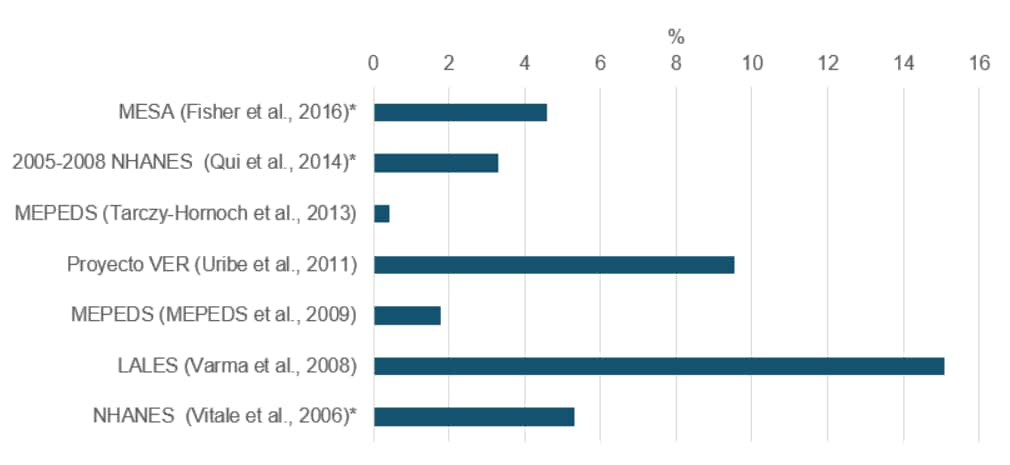Review: Uncorrected Refractive Error
‹View Table of Contents
The VEHSS team conducted a review of published literature on examination-based population studies reporting the prevalence of uncorrected refractive error.
There are four different types of refractive error (RE): myopia, hyperopia, astigmatism, and presbyopia. Myopia, also known as nearsightedness, refers to light focusing in front of the retina, causing distant objects to look blurry.(NEI, 2015) Hyperopia, also known as farsightedness, is caused if the cornea in the front of the eye is too curved and light does not focus correctly.(AOA, 2015) Closer objects are out of focus for people with hyperopia. Astigmatism refers to an irregularly curved lens.(AOA, 2015) Astigmatism often occurs with hyperopia and myopia. Presbyopia is age-related and occurs when the lens loses the flexibility to change, making it hard to focus on close objects.
Download the full report:
Published Examination-Based Prevalence of Major Eye Disorders [PDF – 703 KB]
Refractive error is diagnosed through visual acuity testing, refraction, or a comprehensive eye examination.(Dhaliwal, 2015) Refractive error can be treated with corrective eye glasses, contact lenses, and refractive surgery. Refractive error that is not diagnosed or treated is called uncorrected refractive error (URE). Uncorrected refractive error is often defined as presenting visual acuity (VA) of 20/50 or worse, and best corrected VA of 20/40 or better, indicating that normal acuity may be achieved through refraction correction.(Qui, 2014) Refractive error can remain uncorrected due to the limited availability of practitioners, affordability of examinations and treatments, lack of awareness by the patient or family, and cultural stigmas against glasses.(Qui, 2014)
Uncorrected Refractive Error Literature Review Results
There were 10 studies published between 2005 and 2016 that examined the prevalence of uncorrected refractive error.
Table 1. Uncorrected Refractive Error Prevalence Sources.
| Author | Date of Publication | Title | Date of Data Collection | Data Source | Sample Size | Prevalence Data Stratified by: |
|---|---|---|---|---|---|---|
| Varma R, Choudhury F, et al. | 2016 | Prevalence and Causes of Visual Impairment and Blindness in Chinese American Adults: The Chinese American Eye Study | 2010–2013 | CHES | 4,582 | Race |
| Fisher DE, Shraqer S, et al. | 2015 | Visual Impairment in White, Chinese, Black, and Hispanic Participants from the Multi-Ethnic Study of Atherosclerosis Cohort | 2002–2004 | MESA | 6,134 | Not stratified by demographic variables |
| Qiu M, Wang SY, Singh K, Lin SC. | 2014 | Racial Disparities In Uncorrected and Undercorrected Refractive Error in the United States | 2005–2008 | NHANES | 12,758 | Age, Sex, Race/Ethnicity |
| Uribe JA, Swenor BK, et al | 2011 | Uncorrected Refractive Error in a Latino Population: Proyecto VER | 1997–1999 | Proyecto VER | 4,509 | Age, Sex, Race/Ethnicity |
| Kodjebacheva G, Brown R, et al. | 2011 | Uncorrected Refractive Error Among First-Grade Students of Different Racial/Ethnic Groups in Southern California: Results a Year After School-Mandated Vision Screening | 1999–2006 | UCLA MEC | 11,332 | Age |
| Tarczy-Hornoch, K., et al | 2013 | Prevalence and Causes of Visual Impairment in Asian and Non-Hispanic White Preschool Children: Multi-Ethnic Pediatric Eye Disease Study | Unknown | MEPEDS | 1,840 | Age, Race / Ethnicity |
| MEPEDS Group | 2009 | Prevalence and Causes of Visual Impairment in African-American and Hispanic Preschool Children: the Multi-Ethnic Pediatric Eye Disease Study | Unknown | MEPEDS | 3,207 | Age, Race / Ethnicity |
| Varma R, Wang MY, Ying-Lai M, et al. | 2008 | The Prevalence and Risk Indicators of Uncorrected Refractive Error and Unmet Refractive Need in Latinos: the Los Angeles Latino Eye Study | 2000–2008 | LALES | 6,129 | Age, Sex, Race/Ethnicity |
| Vitale S, Cotch MF, Sperduto RD. | 2006 | Prevalence of Visual Impairment in the United States | 1999–2002 | NHANES | 13,265 | Age, Sex, Race/Ethnicity |
| Mansberger SL, Romero FC, et al. | 2005 | Causes of Visual Impairment and Common Eye Problems in Northwest American Indians and Alaska Natives | Unknown | Nothwest AIAN | 288 | Not stratified by demographic variables |
Overall Refractive Error Prevalence Rates
Figure 1 below shows estimated prevalence rates for uncorrected refractive error (URE) derived from the selected studies. URE rates ranged from 1.8% in the 2013 MEPEDS study to 15.1% in LALES. The high degree of variation among the results in this figure is likely due to in part to methodological, disease definition, and population differences among the studies. The figure is intended to illustrate the range of published prevalence values; direct comparison of the studies is impossible without considering the underlying differences in the studies. Detailed results from each individual study are available in the full report Published Examination-based Prevalence of Major Eye Disorders.
Figure 1. Overall URE Prevalence Rates in Selected Studies.

*Age- or population- adjusted prevalence rate.